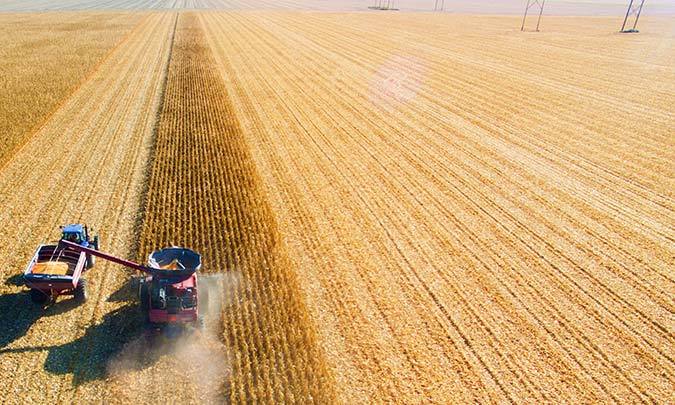Quality Unconcern



PHOTO: STOCK PHOTO
July 14, 2020
BY Susanne Retka Schill
FROM JULY 2020 ISSUE
One piece of good news in the midst of the pandemic and oil collapse was that the 2020 corn crop was off to a better start than last year, albeit still problematic in some areas. The USDA crop progress report at the end of May was showing planting and emergence of the 2020 crop far ahead of last year, on average, and better than the five-year average.
The 2019 growing season presented a wide array of weather-related setbacks for the corn crop from planting to harvest—with some growers harvesting the corn rows they could reach in spite of snow and mud in winter and spring. For ethanol producers, the low test weights, high moisture and high damage counts raised concerns that ethanol yields would take a hit.
“Quality was lower,” says Randy Doyal, CEO of Al-Corn Clean Fuel, in Claremont, Minnesota. “The biggest problem we have seen is with the weakness of the kernel. Damaged, broken corn produces higher fines, resulting in problems with flowability in corn bins and plugging of feed hoppers. [Ethanol] yield is down a touch, probably about par with the amount of material removed during multiple bin cleanings.”
Further west, Ryan Carter, general manager of Tharaldson Ethanol in Casselton, North Dakota, is seeing a wide range of corn quality coming into the plant. “It did not affect the yield like you would have thought. We have processed corn that has been harvested throughout winter and still being harvested in May. Some of that corn improved on moisture. We haven’t seen issues with ethanol yield.”
“There was a lot of trepidation about what could happen,” says Stephanie Gleason, senior manager of technical service at Phibro Ethanol Performance Group. “Michigan, Indiana, Ohio and further east were struggling with low test weights and high moisture. Harvest wasn’t delayed, but quality was very low in that region. The Dakotas and Minnesota were struggling to get corn, because farmers couldn’t take it off the field. They were looking at alternative feedstocks, although, for the most part, they made it through without.”
The U.S. Grains Council’s annual survey found the average quality of the 2019 corn harvest to be lower than the previous year, as well as the five-year average: lower test weight, higher broken kernels, higher total damage and higher moisture. Protein levels were lower, starch content slightly lower and oil content higher. Still, the average aggregate quality, according to the USGC report, “was better than the grade factor requirements for U.S. No. 1 grade corn, indicating an abundant amount of good quality corn is entering the marketing channel from the 2019 U.S. crop.”
The prospect of dealing with low-quality corn prompted numerous questions for the industry’s technical advisers. “There’s no guarantee low quality means lower yields, but it increases the potential,” Gleason says. Lower test weight in itself is not a problem, but is an indicator that other issues may be present. High-moisture corn and high levels of damaged and broken corn create more issues, not only in storage, but in the ethanol process due to the greater susceptibility for contamination by molds and bacteria.
“The microbes aren’t necessarily going to survive into the fermentation process,” Gleason says. “But the byproducts made by the molds can influence fermentation negatively. With bacterial contamination, organic acids are typically the problem.”
“If you have contamination on your corn, you want to reduce the overall stress on your yeast,” she advises. “If yeast health is taking a hit, it could cause further contamination.” Strategies include adopting a robust microbial control program, using a supplement to mitigate nutrient variation and boost yeast health, and, if possible, blending better-quality corn with the damaged feedstock. Producers considering blending in sorghum or wheat to extend feedstock supplies should remember different nutrient packages and enzyme blends are recommended, she adds.
Evaluating Input Costs
Chris Ashworth, technical services manager at Lallemand Biofuels & Distilled Spirits, attributes the better-than-expected ethanol yields from questionable corn quality to plants getting better at their processes. “They’ve got their front ends dialed in,” he says. “Plus, the enzymes on the market now, and the yeast offerings that we and our competitors have out there, are better in yield than they used to be. All of that has translated into not losing as much yield as we thought we would.”
The temptation during the protracted period of tight ethanol margins has been to cut costs by switching to lower-cost options in yeast and enzymes, Ashworth adds. “But starch is by far the biggest cost. You may spend $600 or $800 per fermenter on glucoamylase for one batch, but the amount of corn is 45,000 to 80,000 bushels, depending on the size of the fermenter. You can only minimize costs so much before you need to think about what you’re doing to fermentation and how much ethanol you’re getting per pound of starch.”
Starch content in the 2019 corn was only down slightly, according to the USGC report, but Ashworth points out that measurement is done on a dry basis, while plants generally use corn as-is. “Plants run into problems with higher moisture corn because they’re grinding the same amount of bushels volume-wise. But they are losing starch as they gain water.” Added variation due to corn quality on top of that can increase inconsistency in fermentation. Even though the solids haven’t changed, the amount of starch in fermentation may be fluctuating.
Small fluctuations translate into big numbers at the volumes processed in plants today. Just a 1 percent starch drop can change ethanol yield by .0125 gallons per bushel of ethanol. When a big plant runs 110,000 bushels a day, that starch drop can result in 1,375 gallons of ethanol lost per day, Ashworth says. The added water content also can create inefficiencies in distillation.
Plants see corn quality variability every year, he adds. Some comes from storage issues, particularly from corn piled outside. “Some piles don’t get tarped in time and get wet, so the quality of that corn may not be as good, even though when it was stored it was fine,” he says.
Cyclical Quality
Plants also see yield losses every year when they switch to new crop corn, Ashworth says. “Corn coming straight out of the field doesn’t produce as well as corn that has been stored a month or two. This fall was very similar. Then the yields came back as they normally would.”
Illinois researchers have investigated the cyclical variation in corn quality. “Irrespective of genetic differences in corn hybrids, there are factors that are affecting corn quality throughout the year,” says Vijay Singh, director of the Integrated Bioprocessing Research Laboratory at the University of Illinois, Urbana-Champaign. “Right after harvest, you don’t get very good ethanol yields. About three months later after storing the corn, you start to see peak ethanol yields, then it starts to go down before coming back up later in the year.”
The Illinois study involved running tests on commodity corn sampled every two weeks from a cooperating 100 MMgy plant, using a pure hybrid stored at 4 degrees Celsius as a control. All samples, including the known control hybrid, showed the same cyclical pattern.
Further investigation found changes happening in four types of proteins found in the corn kernel during storage that were affecting ethanol yields, Singh says. Looking for ways to mitigate the variability, the researchers tried using older and newer enzymes in trial runs. “We found there is some effect, but not a significant one in reducing this variability.”
Advertisement
The Case for a Starch Standard
Advertisement
The standard grade used by the U.S. ethanol industry—U.S. No. 2 yellow dent corn—bears little resemblance to what ethanol producers actually need, says Robert Piggot, global technical manager, Lallemand Biofuels & Distilled Spirits.
The standard for No. 2 sets a minimum test weight of 54 pounds per bushel, a maximum of 5 percent total damaged kernels, and a maximum of 3 percent broken corn and foreign material (BCFM).
Moisture isn’t even a part of the official specification, Piggot points out, and differences of 1 to 2 percent moisture make a big difference. “Increased moisture takes more mill amps to grind it, you can’t store it as long, and you get less starch,” he says. “If you’ve got 1 percent more by weight of water, that is roughly 0.68 percent starch you don’t have.”
Test weight and BCFM aren’t as important to an ethanol plant as starch, he says. “What we should be specifying in our purchasing is starch content.” The test isn’t difficult, he says. NIR (near infrared) testing equipment can give moisture, protein and starch levels in one analysis in less than a minute.
Piggot knows of two seed companies that have developed high-starch corn varieties. “There are hybrids with 3 percent more starch,” Piggot adds, “but they cost a bit more so farmers aren’t going to grow them unless they get paid more.”
The plant would gain enough benefit to share with the farmer, Piggot says. Corn containing 3 percent more starch could produce 228 more gallons of ethanol per truckload of corn. At the prices he last used to figure the value ($1.60 ethanol less the reduced DDGS at $137 per ton), a 100 MMgy plant could gain more than $4 million a year.
Author: Susanne Retka Schill
Freelance journalist
retkaschill@yahoo.com
Related Stories
Calumet Inc. on May 9 announced sustainable aviation fuel (SAF) capacity at its Montana Renewables biorefinery is expected to reach 120 MMgy to 150 MMgy sooner than previously reported for a fraction of the originally expected cost.
Tidewater Renewables on May 8 announced that its 3,000-barrel-per-day renewable diesel plant in Prince George, British Columbia, operated at 75% capacity during the first quarter, up from 71% during the same period of last year.
Aemetis Inc. released Q1 results on May 8, reporting increased biogas production, progress with efficiency improvements at the Keyes ethanol plant, and resumed biodiesel deliveries. Financing activities are also underway for a proposed SAF project.
The USDA reduced its estimate for 2024-’25 soybean use in biofuel production in its latest WASDE report, released May 12. The agency expects soybean oil use in biofuel to increase during the 2025-’26 marketing year.
HutanBio's microalgal biofuel production shown to be net-negative in an independent life cycle assessment by EcoAct
HutanBio on May 8 announced that the production process for its proprietary HBx microalgal biofuel achieves net-negative carbon emissions, based on an independent cradle-to-gate life cycle assessment (LCA) conducted by EcoAct.
Upcoming Events










